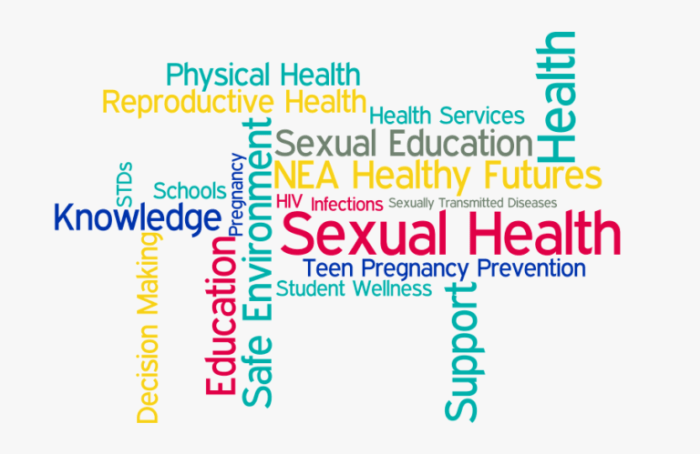
Ever wondered about the fascinating intersection of physical and emotional well-being, specifically as it relates to your sex life? It’s more than just the mechanics; it’s about confidence, connection, and overall happiness. This exploration of sexual health and wellness delves into the nitty-gritty, from understanding your body and relationships to navigating common concerns and promoting inclusivity. Get ready to embark on a journey of self-discovery and empowerment!
We’ll unravel the complexities of sexual health, exploring topics ranging from safe sex practices and STI prevention to the impact of mental health on sexual well-being and the unique needs of diverse communities. We’ll also discuss the importance of open communication, consent, and building healthy, fulfilling relationships. Prepare to learn practical strategies and gain valuable insights that will enhance your overall well-being.
Defining Sexual Health and Wellness
Sexual health and wellness encompass much more than just the physical act of sex. It’s a holistic concept that intertwines physical, emotional, and social well-being, all impacting our overall quality of life. Understanding these interconnected aspects is crucial for navigating the complexities of sexuality and fostering a positive relationship with our bodies and partners.
Components of Comprehensive Sexual Health and Wellness
Comprehensive sexual health and wellness involves a multifaceted approach, acknowledging the interplay of various factors contributing to a fulfilling and healthy sexual life. These components are not isolated but rather interwoven, influencing and supporting each other.
Physical Aspects of Sexual Well-being
Physical sexual health focuses on the biological aspects of sexuality. This includes reproductive health, the absence of sexually transmitted infections (STIs), and the ability to experience pleasure and satisfaction. Regular check-ups, safe sex practices, and open communication with healthcare providers are essential for maintaining physical sexual well-being. For example, understanding your menstrual cycle or managing erectile dysfunction through medical intervention significantly contributes to physical sexual health.
Emotional Aspects of Sexual Well-being
Emotional sexual well-being centers on our feelings, thoughts, and attitudes towards sex and intimacy. It encompasses self-acceptance, body positivity, comfortable communication about desires and boundaries, and the ability to experience pleasure and intimacy without shame or guilt. A strong sense of self-esteem and confidence significantly influences emotional well-being in sexual contexts. For instance, feeling comfortable expressing your needs and desires to a partner is a key component of emotional sexual health.
Social Aspects of Sexual Well-being
Social aspects of sexual well-being involve our interactions with others regarding sexuality. This includes healthy relationships, respecting boundaries, and navigating societal norms and expectations surrounding sex. Open communication, consent, and mutual respect are fundamental for positive social sexual experiences. Societal acceptance of diverse sexual orientations and expressions is also crucial for fostering a supportive and inclusive environment.
For example, having a supportive network of friends and family who respect your sexual identity contributes greatly to social sexual well-being.
Societal Influences on Perceptions of Sexual Health
Societal factors significantly shape our understanding and perceptions of sexual health. Cultural norms, religious beliefs, media representations, and educational systems all play a role in influencing attitudes and behaviors. For example, some cultures may have restrictive views on premarital sex, while others may be more open and accepting. Media often portrays unrealistic or stereotypical representations of sexuality, which can affect self-esteem and body image.
Comprehensive sex education in schools can help counter negative influences and promote healthy sexual development.
Infographic: Interconnectedness of Physical and Mental Health in Sexual Wellness
The following table illustrates the interconnectedness between physical and mental health in relation to sexual wellness.
| Physical Health | Mental Health | Impact on Sexual Wellness | Example |
|---|---|---|---|
| Reproductive health (e.g., regular check-ups, STI testing) | Body positivity and self-esteem | Increased comfort and confidence in sexual activity | Regular gynecological exams can lead to early detection of issues and improved comfort with one’s body. |
| Physical fitness and energy levels | Stress management and anxiety reduction | Enhanced libido and sexual performance | Regular exercise can reduce stress and improve overall energy levels, positively impacting sexual desire. |
| Absence of chronic illnesses affecting sexual function | Emotional regulation and communication skills | Improved intimacy and satisfaction in relationships | Managing diabetes effectively can improve circulation and erectile function. |
| Proper nutrition and sleep | Positive self-image and acceptance of one’s sexuality | Increased sexual desire and enjoyment | Adequate sleep and a balanced diet contribute to overall well-being and can enhance sexual experiences. |
Sexual Health Education and Awareness
Understanding and promoting sexual health is crucial for individual well-being and societal progress. Comprehensive sex education plays a vital role in empowering individuals with the knowledge and skills to make informed decisions about their sexual health throughout their lives. This involves addressing various aspects, from puberty and relationships to consent, safe sex practices, and understanding different sexual orientations and identities.
The Importance of Sex Education Across Life Stages
Sex education should be a continuous process, adapting to the developmental needs of individuals at different ages. During childhood, age-appropriate discussions about body parts, boundaries, and personal safety are essential. As children enter adolescence, education should expand to encompass puberty, reproductive health, healthy relationships, and consent. Young adults benefit from information on contraception, sexually transmitted infections (STIs), and healthy sexual communication.
Adults may need education on sexual health changes related to aging, managing menopause or andropause, and maintaining intimacy. Continuous learning throughout life ensures individuals possess the knowledge to navigate the complexities of their sexual health at every stage.
Challenges and Opportunities in Providing Comprehensive Sex Education
Implementing effective sex education faces several challenges. These include societal resistance from religious or cultural groups who oppose certain aspects of comprehensive sex education, such as discussions about contraception or LGBTQ+ identities. Funding limitations can also restrict the availability and quality of programs. Furthermore, there’s a need for adequately trained educators who are comfortable and knowledgeable enough to deliver sensitive information in an inclusive and engaging manner.
Despite these challenges, opportunities exist to leverage technology, such as online resources and interactive platforms, to make sex education more accessible and engaging. Partnerships between schools, healthcare providers, and community organizations can also enhance the reach and impact of sex education initiatives. By addressing these challenges proactively, we can create more opportunities for comprehensive and effective sexual health education.
Common Misconceptions Surrounding Sexual Health and Accurate Information
Many misconceptions surround sexual health, leading to risky behaviors and poor health outcomes. For example, the myth that STIs only affect certain groups is false; anyone sexually active can contract an STI. Another common misconception is that withdrawal is a reliable form of contraception; it is not, and it offers little to no protection against pregnancy or STIs.
The belief that abstinence is the only way to avoid pregnancy or STIs is also inaccurate; comprehensive sex education should highlight the importance of safe sex practices, including the use of condoms and other forms of contraception. Accurate information dispels these myths and empowers individuals to make informed decisions. Reliable sources, such as those listed below, are crucial for accessing factual and unbiased sexual health information.
Reliable Resources for Sexual Health Information
Accessing accurate information is key to making informed decisions about sexual health. Here are some reliable resources:
- Planned Parenthood: Offers a wide range of sexual and reproductive health services and information.
- Scarleteen: Provides comprehensive and inclusive sex education for teens and young adults.
- The Centers for Disease Control and Prevention (CDC): Offers reliable data and information on STIs, HIV/AIDS, and other sexual health topics.
- National Institutes of Health (NIH): Provides research-based information on sexual health and related conditions.
Addressing Common Sexual Health Concerns
Maintaining good sexual health is crucial for overall well-being. Understanding common concerns, their causes, and preventative measures empowers individuals to make informed decisions and protect their health. This section will address some of the most prevalent sexually transmitted infections (STIs) and highlight the importance of regular checkups and safe sex practices.
Common Sexually Transmitted Infections (STIs)
Sexually transmitted infections are passed from one person to another through sexual contact. Early detection and treatment are vital to prevent long-term health complications. The following table summarizes information on some common STIs.
| STI | Symptoms | Causes | Treatments |
|---|---|---|---|
| Chlamydia | Often asymptomatic in women; men may experience burning during urination and penile discharge. Women may experience abnormal vaginal discharge or bleeding. | Chlamydia trachomatis bacteria | Antibiotics (e.g., azithromycin, doxycycline) |
| Gonorrhea | Similar to chlamydia; men may experience painful urination and pus-like discharge. Women may experience vaginal bleeding between periods. | Neisseria gonorrhoeae bacteria | Antibiotics (treatment regimens vary and are becoming increasingly complex due to antibiotic resistance) |
| Syphilis | Stages progress from a painless sore (chancre) to rash, fever, and potentially serious organ damage if left untreated. | Treponema pallidum bacteria | Antibiotics (penicillin) |
| Genital Herpes | Painful blisters or sores on the genitals, buttocks, or thighs. Outbreaks can recur. | Herpes simplex virus (HSV) types 1 and 2 | Antiviral medications (e.g., acyclovir, valacyclovir) to manage outbreaks and reduce recurrences. No cure. |
| Human Papillomavirus (HPV) | Often asymptomatic; can cause genital warts or cervical cancer. | Human papillomavirus (various types) | Treatment focuses on removing warts; HPV vaccines are available for prevention. |
| Trichomoniasis | Women may experience vaginal itching, burning, and a foul-smelling discharge. Men often have no symptoms. | Trichomonas vaginalis parasite | Antibiotics (e.g., metronidazole) |
Impact of STIs on Overall Health and Well-being
Untreated STIs can lead to serious health consequences, including infertility, pelvic inflammatory disease (PID), ectopic pregnancies, increased risk of HIV infection, and certain cancers. Beyond the physical effects, the emotional and psychological toll of an STI diagnosis can be significant, impacting self-esteem, relationships, and mental health. Early diagnosis and treatment are key to minimizing these risks.
Importance of Regular Sexual Health Checkups
Regular sexual health checkups are essential for early detection and treatment of STIs and other sexual health concerns. These checkups may include screenings for STIs, Pap smears (for women), and discussions about sexual health practices and concerns. The frequency of checkups depends on individual risk factors and sexual activity. Seeking professional guidance on appropriate screening intervals is recommended.
Safe Sex Practices and Preventative Measures
Practicing safe sex is the most effective way to prevent STIs. This includes:* Consistent and correct use of condoms during sexual intercourse.
- Limiting the number of sexual partners.
- Open and honest communication with partners about sexual health history and practices.
- Getting vaccinated against HPV.
- Regular STI testing, especially if engaging in high-risk sexual behaviors.
- Understanding and avoiding risky sexual behaviors such as unprotected sex, sharing needles, and sexual contact with multiple partners.
Sexual Health and Relationships
Navigating the world of sexual health isn’t just about physical well-being; it’s deeply intertwined with the quality of our relationships. Open communication, mutual respect, and a shared understanding of boundaries are the cornerstones of a healthy and fulfilling sexual life. This section explores how relationships influence sexual health and offers strategies for building strong, positive connections.
Communication and Consent in Healthy Sexual Relationships
Effective communication is paramount in any relationship, but it’s especially crucial when discussing sex. Open dialogue about desires, boundaries, and comfort levels ensures that both partners feel heard, respected, and safe. Consent, which must be freely given, enthusiastic, and ongoing, is not just a legal requirement but a fundamental aspect of healthy intimacy. It’s a continuous process, not a one-time event, and can be withdrawn at any point.
A healthy sexual relationship is built on a foundation of mutual respect and the understanding that “no” always means “no.” Furthermore, silence or ambiguity does not equate to consent.
Relationship Dynamics and Their Impact on Sexual Health
Different relationship structures—monogamous, polyamorous, or asexual—impact sexual health in various ways. Monogamous relationships often prioritize exclusivity and long-term commitment, potentially fostering deeper emotional intimacy and sexual satisfaction. Polyamorous relationships, involving multiple consensual partners, require strong communication and boundary-setting to ensure everyone’s needs are met. Asexual relationships, characterized by a lack of sexual attraction, demonstrate that fulfilling relationships can exist outside of sexual activity.
The key to a positive impact on sexual health in any relationship structure is open communication, mutual respect, and a shared understanding of each partner’s needs and desires.
Strategies for Building Healthy and Fulfilling Sexual Relationships
Building strong sexual relationships requires ongoing effort and commitment. Prioritizing quality time together, engaging in open and honest communication, exploring each other’s sexual preferences, and showing affection and appreciation are essential. Regular check-ins about sexual satisfaction, incorporating intimacy beyond sexual intercourse, and seeking professional guidance when needed are all valuable strategies. Remember that intimacy encompasses a wide range of experiences, from physical touch and emotional connection to shared activities and meaningful conversations.
Regularly expressing appreciation for one another and celebrating milestones strengthens the bond and enhances intimacy.
Resources for Couples Seeking Support with Sexual Health Challenges
Many resources are available for couples facing sexual health challenges. Seeking professional help is a sign of strength, not weakness.
- Relationship Therapists: Can help improve communication, address relationship conflicts, and navigate intimacy issues.
- Sex Therapists: Specialize in addressing sexual concerns and dysfunctions, providing education and tailored strategies.
- Medical Doctors: Can diagnose and treat medical conditions affecting sexual health.
- Online Resources: Reputable websites and organizations offer information and support on various sexual health topics. Always ensure the source is credible and evidence-based.
- Support Groups: Connecting with others facing similar challenges can provide valuable emotional support and practical advice.
Women & Health
Understanding and prioritizing women’s reproductive health is crucial for overall well-being and quality of life. This section delves into the intricacies of the female reproductive system, highlighting key aspects for maintaining optimal health throughout a woman’s lifespan. We’ll explore the importance of regular checkups, navigate the different stages of reproductive life, examine common health concerns, and empower women to advocate effectively for their needs.
The Importance of Regular Gynecological Checkups
Regular visits to a gynecologist are essential for preventative care and early detection of potential problems. These checkups allow for screenings, such as Pap smears to detect cervical cancer and HPV, and pelvic exams to assess overall reproductive health. Early detection significantly improves treatment outcomes and can prevent serious health complications. The frequency of these visits varies based on individual needs and age, but generally, annual checkups are recommended for women who are sexually active or over the age of 21.
Beyond screenings, these visits provide an opportunity to discuss any concerns, ask questions, and receive personalized advice regarding reproductive health.
Stages of a Woman’s Reproductive Life Cycle
A woman’s reproductive life is characterized by distinct stages, each with its own unique health considerations. Puberty marks the beginning, with the onset of menstruation and the development of secondary sexual characteristics. This stage often involves navigating changes in body image and understanding menstrual cycles. The reproductive years, spanning from puberty to menopause, are characterized by ovulatory cycles, potential for pregnancy, and associated hormonal fluctuations.
Menopause, signifying the end of menstruation, brings its own set of changes, including hormonal shifts that can impact bone density, cardiovascular health, and mood. Understanding these stages allows for proactive management of health concerns specific to each phase.
Common Reproductive Health Issues and Their Management
Several common reproductive health issues affect women throughout their lives. These include premenstrual syndrome (PMS), characterized by symptoms like mood swings, bloating, and cramping; endometriosis, where uterine tissue grows outside the uterus; and polycystic ovary syndrome (PCOS), a hormonal disorder affecting ovulation and potentially leading to infertility. Sexually transmitted infections (STIs) pose another significant concern, requiring prompt diagnosis and treatment to prevent complications.
Effective management often involves lifestyle adjustments, medication, or surgical intervention, depending on the specific condition. Early diagnosis and appropriate treatment are key to mitigating the impact of these conditions.
Advocating for Your Reproductive Health Needs
Effectively advocating for your reproductive health involves several key steps. First, be proactive in scheduling regular checkups and expressing any concerns to your gynecologist. Second, thoroughly research any conditions or treatments, empowering yourself with knowledge to engage in informed discussions with healthcare professionals. Third, don’t hesitate to seek second opinions if you feel unsure or dissatisfied with a particular diagnosis or treatment plan.
Fourth, maintain open communication with your partner or support system about your reproductive health concerns and needs. Finally, remember that you have the right to make informed decisions about your body and reproductive health. Assertiveness and proactive engagement are essential for receiving the best possible care.
Women & Health

Menopause, that significant life transition for women, often brings a whirlwind of physical and emotional changes. While it marks the end of menstruation and fertility, it’s crucial to understand its impact on sexual health and well-being, and to embrace strategies for navigating this new phase with confidence and vitality. This section will explore the physiological shifts associated with menopause, strategies for managing related symptoms, and the ongoing importance of sexual health awareness beyond this stage of life.
Physiological Changes During Menopause and Their Impact on Sexual Health
The decline in estrogen levels during menopause triggers a cascade of changes affecting the urogenital system. Vaginal dryness, a common complaint, results from decreased lubrication and thinning of the vaginal walls. This can lead to discomfort during intercourse, making it painful or even impossible. Reduced elasticity in the vaginal tissues can also contribute to this discomfort. Additionally, decreased blood flow to the vulva and clitoris can impact sexual arousal and sensation.
These physiological changes can significantly impact a woman’s libido and overall sexual satisfaction, leading to decreased sexual desire and frequency. However, it’s important to note that these changes are not inevitable and are manageable with appropriate interventions.
Strategies for Managing Menopausal Symptoms Affecting Sexual Well-being
Fortunately, numerous strategies can effectively alleviate menopausal symptoms impacting sexual health. Hormone replacement therapy (HRT) remains a viable option for many women, restoring estrogen levels and alleviating vaginal dryness and other symptoms. However, it’s crucial to discuss the potential risks and benefits with a healthcare professional to determine suitability. Lubricants and moisturizers can provide immediate relief from vaginal dryness, facilitating comfortable intercourse.
Pelvic floor exercises, such as Kegel exercises, can strengthen the pelvic muscles, improving vaginal tone and reducing urinary incontinence, a common menopausal symptom that can negatively impact sexual function. Lifestyle modifications, including regular exercise, a balanced diet, stress management techniques (such as yoga or meditation), and adequate sleep, can also contribute significantly to overall well-being and sexual health.
Open communication with a partner is also essential, fostering understanding and support during this transition.
Continued Sexual Health Awareness After Menopause
Menopause does not signal the end of a woman’s sexual life; rather, it signifies a transition requiring adjustments and a renewed focus on self-care. Maintaining open communication with a healthcare provider about any changes or concerns is crucial. Regular check-ups can help identify and address potential issues promptly. Continued sexual activity, when desired and comfortable, can contribute to overall physical and mental well-being.
Exploring different ways to achieve intimacy and pleasure, perhaps experimenting with alternative forms of sexual expression, can help maintain a fulfilling sexual life. It’s also important to remember that many women experience a renewed sense of sexual freedom after menopause, as the constraints of fertility concerns are no longer present. Embracing this new chapter with a positive and proactive approach is key.
Resources and Support for Women Going Through Menopause
Menopause is a natural process, not an illness, and support is readily available.
Open communication with your doctor is key to managing symptoms effectively.
Explore various options, including HRT, lifestyle changes, and alternative therapies.
A brochure outlining resources and support would include:
Contact your healthcare provider: Discuss your symptoms and explore treatment options tailored to your individual needs. This is the first and most important step.
Support groups: Connecting with other women going through menopause can provide emotional support and practical advice. Many local organizations and online communities offer such support.
Therapists and counselors: Addressing emotional and psychological aspects of menopause can significantly improve overall well-being.
Reliable online resources: Reputable websites and organizations provide evidence-based information on menopause and its management. Be wary of misinformation.
Alternative therapies: Some women find relief through practices such as acupuncture, yoga, and meditation. Always consult your doctor before starting any new therapies.
Sexual Health and Mental Well-being
Our mental and sexual health are intricately linked, influencing each other in profound ways. A healthy mind contributes significantly to a fulfilling and satisfying sex life, while mental health challenges can significantly impact sexual function and desire. Understanding this connection is crucial for achieving holistic well-being.
The Interplay of Mental Health and Sexual Health
Mental health conditions such as anxiety, depression, and trauma can significantly affect sexual health. For example, anxiety can lead to performance anxiety, impacting arousal and orgasm. Depression can decrease libido and motivation, leading to a lack of interest in sex. Trauma, particularly sexual trauma, can result in avoidance of intimacy, pain during intercourse, and difficulty experiencing pleasure. Conversely, experiencing sexual difficulties can exacerbate existing mental health issues or trigger new ones, creating a cyclical pattern.
This highlights the importance of addressing both mental and sexual health concerns holistically.
Anxiety’s Impact on Sexual Function
Anxiety disorders, characterized by excessive worry and fear, frequently disrupt sexual function. The heightened state of anxiety can interfere with arousal, leading to difficulty achieving or maintaining an erection in men and vaginal lubrication in women. The constant worry about performance can create a self-fulfilling prophecy, leading to further anxiety and sexual dysfunction. Individuals experiencing anxiety-related sexual difficulties often benefit from cognitive behavioral therapy (CBT) which helps to identify and challenge negative thought patterns.
Depression and Reduced Sexual Desire
Depression, a mood disorder characterized by persistent sadness and loss of interest, significantly impacts libido. The lack of energy, motivation, and overall pleasure associated with depression extends to sexual activity. Furthermore, the hormonal imbalances often associated with depression can also contribute to decreased sexual desire and function. Treatment for depression, including medication and therapy, can often improve sexual function as overall mood and energy levels improve.
Trauma’s Influence on Intimacy and Pleasure
Trauma, especially sexual trauma, can profoundly affect an individual’s ability to experience intimacy and sexual pleasure. This can manifest as avoidance of sexual activity, difficulty relaxing during intimacy, pain during intercourse (dyspareunia), and a diminished capacity for pleasure. Specialized therapies, such as trauma-focused cognitive behavioral therapy (TF-CBT) and EMDR (Eye Movement Desensitization and Reprocessing), can be particularly effective in addressing the impact of trauma on sexual health.
These therapies help individuals process their trauma and develop coping mechanisms to manage the emotional and physical challenges they face.
Strategies for Improving Mental Well-being to Enhance Sexual Health
Prioritizing mental well-being is paramount for optimal sexual health. This involves engaging in regular self-care practices, such as:
- Regular exercise: Physical activity releases endorphins, which have mood-boosting effects and can improve overall energy levels.
- Mindfulness and meditation: These practices can help reduce stress and anxiety, promoting relaxation and improving focus.
- Sufficient sleep: Adequate sleep is crucial for both physical and mental health, impacting energy levels, mood, and sexual function.
- Healthy diet: A balanced diet provides the necessary nutrients for optimal brain function and overall well-being.
- Social connection: Maintaining strong social connections provides support and reduces feelings of isolation.
- Professional help: Seeking therapy or counseling can provide valuable support and guidance in addressing mental health challenges.
Engaging in these practices fosters a positive feedback loop, where improved mental well-being contributes to better sexual health, and improved sexual health reinforces positive mental well-being.
Self-Care Practices and Overall Sexual Wellness
Self-care is not a luxury; it’s a necessity for holistic well-being, including sexual health. It involves actively engaging in activities that promote physical and mental health, fostering a sense of self-worth and confidence. These activities can be simple yet profoundly impactful, such as taking a relaxing bath, reading a book, spending time in nature, or pursuing a hobby.
By prioritizing self-care, individuals cultivate a sense of self-compassion and acceptance, creating a foundation for healthier relationships and a more fulfilling sex life. Self-care is a powerful tool for managing stress, enhancing mood, and improving overall sexual wellness. It’s about nurturing oneself both physically and emotionally to cultivate a positive relationship with one’s body and sexuality.
Promoting Inclusivity in Sexual Health
Sexual health is a fundamental aspect of overall well-being, and ensuring equitable access to information and services is crucial for everyone. However, many marginalized communities face significant barriers to achieving optimal sexual health. Promoting inclusivity means actively working to dismantle these barriers and create a supportive environment where individuals from all backgrounds can feel comfortable seeking and receiving the care they need.
Diverse populations experience unique sexual health needs and challenges. Understanding and addressing these disparities is vital for improving health outcomes and promoting social justice.
Unique Sexual Health Needs of Diverse Populations
LGBTQ+ individuals, for example, may face discrimination from healthcare providers, leading to a reluctance to seek care. They also have specific health concerns, such as increased risk of certain sexually transmitted infections (STIs) due to societal stigma and lack of inclusive healthcare. People with disabilities may encounter physical barriers to accessing services, such as inaccessible clinic facilities or a lack of adapted medical equipment.
Furthermore, communication challenges and societal biases can further limit their access to appropriate care. Addressing these unique needs requires culturally sensitive and inclusive approaches to sexual health education and service provision.
Barriers to Accessing Sexual Health Services for Marginalized Communities
Several barriers prevent marginalized communities from accessing sexual health services. Financial constraints, lack of health insurance, and geographical limitations are significant obstacles. Language barriers, cultural differences, and a lack of culturally competent healthcare providers further complicate access. Additionally, fear of discrimination, judgment, or negative consequences can prevent individuals from seeking help, especially for those who are already vulnerable due to their sexual orientation, gender identity, disability, or other factors.
This highlights the urgent need for proactive strategies to overcome these barriers.
Strategies for Creating Inclusive and Accessible Sexual Health Resources and Services
Creating inclusive and accessible sexual health resources and services requires a multi-pronged approach. This includes providing culturally competent training for healthcare providers, ensuring that facilities are physically accessible, and offering services in multiple languages. Developing inclusive educational materials that reflect the diversity of the population is essential. This includes using inclusive language and imagery that represents all genders, sexual orientations, and abilities.
Furthermore, promoting telehealth options can expand access for those in remote areas or with mobility challenges. Creating safe and non-judgmental spaces where individuals feel comfortable seeking help is paramount.
Organizations Advocating for Inclusive Sexual Health Practices
Access to comprehensive sexual health information and services is a fundamental human right. Several organizations actively work to promote inclusivity and address the unique needs of diverse populations. Their advocacy efforts are crucial for ensuring that everyone has the opportunity to achieve optimal sexual health.
It’s important to note that this is not an exhaustive list, and many other organizations at local, national, and international levels contribute to this vital work.
- Planned Parenthood: Offers a wide range of sexual and reproductive health services, including education, testing, and treatment, with a focus on inclusivity.
- The Trevor Project: Provides crisis intervention and suicide prevention services to LGBTQ young people.
- National LGBTQ Task Force: Advocates for LGBTQ rights and works to improve the health and well-being of LGBTQ individuals.
- SNAF (Sexuality Information and Education Council of the United States): Promotes comprehensive sexuality education for all ages.
- Disability Rights Education & Defense Fund (DREDF): Works to advance the rights of people with disabilities, including access to healthcare.
Ultimate Conclusion

Understanding and prioritizing your sexual health and wellness is a journey of self-discovery and empowerment. By embracing open communication, practicing safe sex, and seeking support when needed, you can cultivate healthy relationships and a fulfilling sex life. Remember, sexual health is an integral part of overall well-being, and taking proactive steps to understand and care for this aspect of your life will lead to a richer, more joyful existence.
So, let’s continue the conversation and empower each other to live healthier, happier lives!
Questions Often Asked
What are some common myths about sexual health?
Many myths surround sexual health, such as the belief that STIs only affect certain groups or that abstinence is the only way to prevent them. Accurate information is key to dispelling these myths and promoting healthy sexual practices.
How often should I have a sexual health checkup?
The frequency of checkups depends on your individual risk factors and sexual activity. Consult your doctor to determine a schedule that’s right for you.
Where can I find reliable information about sexual health?
Reputable sources include your doctor, Planned Parenthood, and the CDC website.
What should I do if I think I might have an STI?
See a doctor immediately for testing and treatment. Early diagnosis and treatment are crucial for preventing complications.
How can I talk to my partner about sexual health concerns?
Open and honest communication is key. Create a safe space to discuss concerns and needs without judgment.





